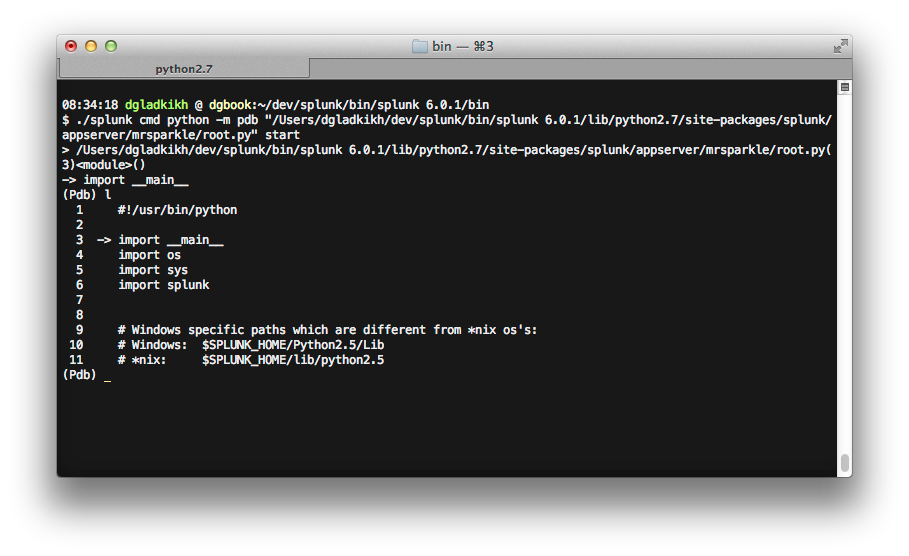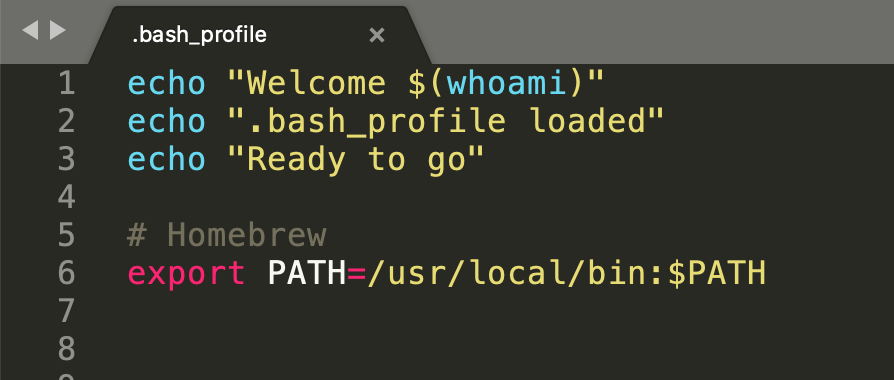Mac Os Sierra Command Line Library Python
Bob Savage <bobsavage@mac.com>

Os — Miscellaneous operating system interfaces¶. This module provides a portable way of using operating system dependent functionality. If you just want to read or write a file see open, if you want to manipulate paths, see the os.path module, and if you want to read all the lines in all the files on the command line see the fileinput module. For me /Applications/Python 3.6/./Install Certificates command fails on pip certifi install. I am on mac High Sierra and use python3 so pip somewhat fails and I have to use pip3 instead. So here what I did: Manually ran pip3 install -update certify in a shell; Remove the install certifi line from the command script. How to run a Python script¶. Your best way to get started with Python on Mac OS X is through the IDLE integrated development environment, see section The IDE and use the Help menu when the IDE is running. If you want to run Python scripts from the Terminal window command line or from the Finder you first need an editor to create your script.
Oct 04, 2016 MacOS comes by default with Python 2.7 which, at this point, receives only bug fixes and will be EOL by 2020. Python 3.x is the future and it is supported by all major Python libraries. In this tutorial, we’ll use Python 3.8. Start by installing the Command Line Tools for macOS. Installing ROS Kinetic on Mac OS X - El Capitan and macOS Sierra. Having rather painlessly installed ROS Indigo on El Capitan using Mike Purvis's script, I attempted to upgrade to ROS Kinetic. This gist outlines the problems I encoutered and how I solved them. Python on a Macintosh running Mac OS X is in principle very similar to Python on any other Unix platform, but there are a number of additional features such as the IDE and the Package Manager that are worth pointing out. The Mac-specific modules are documented in Mac OS X specific services. Python on Mac OS 9.
Python on a Macintosh running Mac OS X is in principle very similar to Python onany other Unix platform, but there are a number of additional features such asthe IDE and the Package Manager that are worth pointing out.
4.1. Getting and Installing MacPython¶
Mac OS X 10.8 comes with Python 2.7 pre-installed by Apple. If you wish, youare invited to install the most recent version of Python 3 from the Pythonwebsite (https://www.python.org). A current “universal binary” build of Python,which runs natively on the Mac’s new Intel and legacy PPC CPU’s, is availablethere.
What you get after installing is a number of things:
A
Python3.8folder in yourApplicationsfolder. In hereyou find IDLE, the development environment that is a standard part of officialPython distributions; PythonLauncher, which handles double-clicking Pythonscripts from the Finder; and the “Build Applet” tool, which allows you topackage Python scripts as standalone applications on your system.A framework
/Library/Frameworks/Python.framework, which includes thePython executable and libraries. The installer adds this location to your shellpath. To uninstall MacPython, you can simply remove these three things. Asymlink to the Python executable is placed in /usr/local/bin/.
The Apple-provided build of Python is installed in/System/Library/Frameworks/Python.framework and /usr/bin/python,respectively. You should never modify or delete these, as they areApple-controlled and are used by Apple- or third-party software. Remember thatif you choose to install a newer Python version from python.org, you will havetwo different but functional Python installations on your computer, so it willbe important that your paths and usages are consistent with what you want to do.
IDLE includes a help menu that allows you to access Python documentation. If youare completely new to Python you should start reading the tutorial introductionin that document.
If you are familiar with Python on other Unix platforms you should read thesection on running Python scripts from the Unix shell.
4.1.1. How to run a Python script¶
Your best way to get started with Python on Mac OS X is through the IDLEintegrated development environment, see section The IDE and use the Help menuwhen the IDE is running.
If you want to run Python scripts from the Terminal window command line or fromthe Finder you first need an editor to create your script. Mac OS X comes with anumber of standard Unix command line editors, vim andemacs among them. If you want a more Mac-like editor,BBEdit or TextWrangler from Bare Bones Software (seehttp://www.barebones.com/products/bbedit/index.html) are good choices, as isTextMate (see https://macromates.com/). Other editors includeGvim (http://macvim-dev.github.io/macvim/) and Aquamacs(http://aquamacs.org/).
To run your script from the Terminal window you must make sure that/usr/local/bin is in your shell search path.
To run your script from the Finder you have two options:
Drag it to PythonLauncher
Select PythonLauncher as the default application to open yourscript (or any .py script) through the finder Info window and double-click it.PythonLauncher has various preferences to control how your script islaunched. Option-dragging allows you to change these for one invocation, or useits Preferences menu to change things globally.
4.1.2. Running scripts with a GUI¶
With older versions of Python, there is one Mac OS X quirk that you need to beaware of: programs that talk to the Aqua window manager (in other words,anything that has a GUI) need to be run in a special way. Use pythonwinstead of python to start such scripts.
With Python 3.8, you can use either python or pythonw.
4.1.3. Configuration¶
Python on OS X honors all standard Unix environment variables such asPYTHONPATH, but setting these variables for programs started from theFinder is non-standard as the Finder does not read your .profile or.cshrc at startup. You need to create a file~/.MacOSX/environment.plist. See Apple’s Technical Document QA1067 fordetails.
For more information on installation Python packages in MacPython, see sectionInstalling Additional Python Packages.
4.2. The IDE¶
MacPython ships with the standard IDLE development environment. A goodintroduction to using IDLE can be found athttp://www.hashcollision.org/hkn/python/idle_intro/index.html.
4.3. Installing Additional Python Packages¶
Mac Os Sierra Command Line Library Python Free

There are several methods to install additional Python packages:
Packages can be installed via the standard Python distutils mode (
pythonsetup.pyinstall).Many packages can also be installed via the setuptools extensionor pip How to locate your itunes music library on mac free. wrapper, see https://pip.pypa.io/.
4.4. GUI Programming on the Mac¶
There are several options for building GUI applications on the Mac with Python.
PyObjC is a Python binding to Apple’s Objective-C/Cocoa framework, which isthe foundation of most modern Mac development. Information on PyObjC isavailable from https://pypi.org/project/pyobjc/.
The standard Python GUI toolkit is tkinter, based on the cross-platformTk toolkit (https://www.tcl.tk). An Aqua-native version of Tk is bundled with OSX by Apple, and the latest version can be downloaded and installed fromhttps://www.activestate.com; it can also be built from source.
wxPython is another popular cross-platform GUI toolkit that runs natively onMac OS X. Packages and documentation are available from https://www.wxpython.org.
PyQt is another popular cross-platform GUI toolkit that runs natively on MacOS X. More information can be found athttps://riverbankcomputing.com/software/pyqt/intro.
4.5. Distributing Python Applications on the Mac¶
The “Build Applet” tool that is placed in the MacPython 3.6 folder is fine forpackaging small Python scripts on your own machine to run as a standard Macapplication. This tool, however, is not robust enough to distribute Pythonapplications to other users.
The standard tool for deploying standalone Python applications on the Mac ispy2app. More information on installing and using py2app can be foundat http://undefined.org/python/#py2app.
4.6. Other Resources¶
The MacPython mailing list is an excellent support resource for Python users anddevelopers on the Mac:
Another useful resource is the MacPython wiki:
Here are some specific instructions on how to setup your Mac OS X machine torun opensauce-python using the Homebrew package manager.
You need to install Python 2.7 or 3.4+ and the Python packages that OpenSaucedepends on.
We describe how to do this using the Homebrew package manager. Follow theinstructions on the Homebrew website to install it. Thenrun
to see how you can configure your system so that Homebrew is in your path. Forexample, you can add the line export PATH='/usr/local/bin:$PATH' to your.bash_profile.
If you want Python 2, do
If you want to install the Python 3 versions, use
In the above, we suggest using virtual environments as this is standardpractice. The command beginning with virtualenv creates a new virtualenvironment named osenv. The command beginning with source activates thevirtual environment, so that when you install numpy and scipy in the nextcommand, these packages are installed into the virtual environment. To exit thevirtual environment, run deactivate on the command line.
To learn more about Python virtual environments, see thevirtualenv documentation.
(Note that Homebrew now uses Python 3 as the default, so you need to installboth Python 2 and Python 3. Apparently, there are some dependencies or linkingissues that are resolved by doing this.)
To run the Homebrew's Python (not the pre-installed version on OS X), use$ python2 or $ python3 depending on which Python version you want to run.
Python Os System Command
Now the Homebrew package versions of Python, NumPy, and SciPy areinstalled.
Install REAPER via thepyreaper Python package, by using thePython package manager pip.
For Python 2, run
or for Python 3, run
We try to maintain pyreaper to stay up-to-date with the official GoogleREAPER repository, but this may not alwaysbe the case. Installing REAPER via the pyreaper Python package is easiest, butalternatively, you can build the REAPER executable as described in theREAPER README. Building theREAPER executable from the official Google repository may be desirable if youneed the latest version of REAPER. In order to build the REAPER executable,you may need to install cmake via Homebrew, i.e. run brew install cmake.
On many versions of OS X, Snack is installed by default as a Tcl/Tk 8.4library. If this is the case, we can simply run Snack commands through the Tclinterpreter using tclsh8.4.
However, for Mac OS X High Sierra, Mojave, and later versions(Mac OS X 10.13+), Tcl/Tk8.4 and Snack arenot installed by default.
Mac OS X High Sierra and Mojave come with Tcl/Tk8.5 pre-installed. We havecompiled a Snack Tcl 8.5 binary that you can download and use, in order to runSnack calculations. The binary has been successfully tested on both Mac OS XHigh Sierra (Mac OS X 10.13) and Mac OS X Mojave (Mac OS X 10.14).
The instructions below explain how you can download the Snack Tcl 8.5 binarieswhich we have pre-built, then place the Snack library files in the standard Tcllibrary directory where Tcl looks for packages.
First, download theSnack Tcl 8.5 zip file.
Then unzip the file to the Tcl library directory. On Mac OS X, Tcl8.5 looksfor packages in
/System/Library/Tcl/8.5.Note: on Mac OS X El Capitan and later,System Integrity Protection isenabled by default and will prevent you from being able to modify anythingin the /System directory. You need to first disable it, followinginstructions here.
Also with Invert turned on the pictures are turned into negative film, verses the picture being true to its color (normal looking photo) like it has in the past to view a normal looking photo with the dark background and white text. If I highlight text with Invert off, then turn Invert on only the highlighted text is visible. If accessability features, especially the Invert feature, can be fixed, it would be much appreciated. Everything else not highlighted is BLANK. When Invert is turned off, the text is visible. Installing the watchtower library on a mac.
Run the following command to unzip the Snack Tcl library files to thestandard Tcl library directory:
Check that Tcl can find the Snack library, by running the Tclsh shell.
When you run the tclsh command package require snack, it should output
2.2if the Snack library has been installed correctly. If instead it outputcan't find package snack, then the install failed.
If you want to compile the Snack Tcl library from source yourself or if thebinary does not work, you can take a look at our notes for building Snack onMac OS X here.